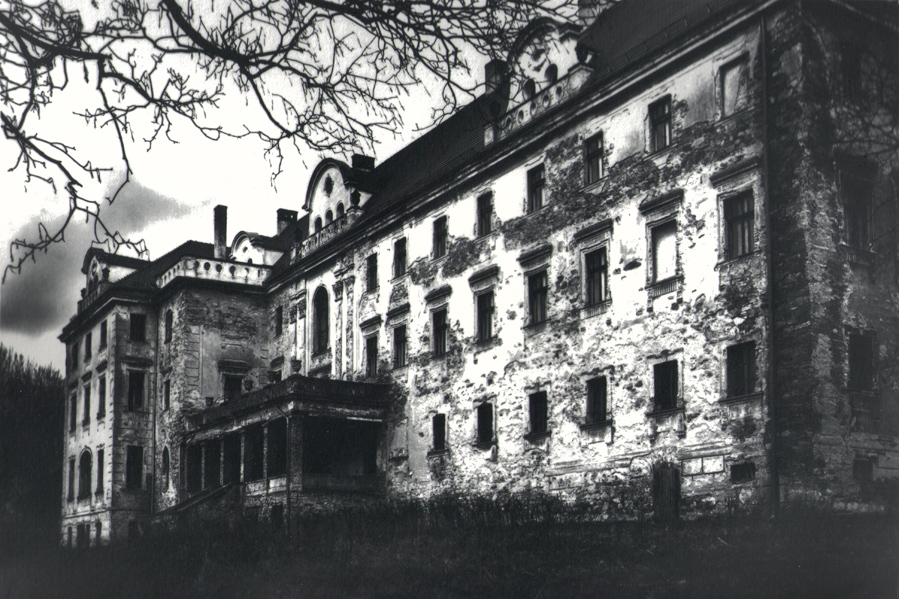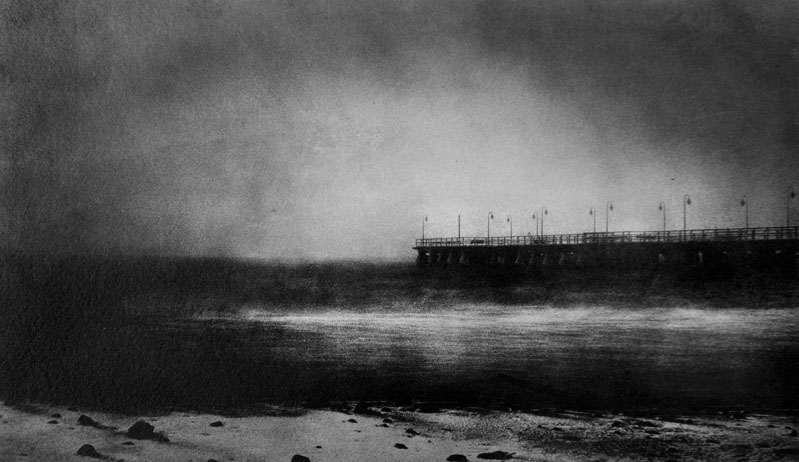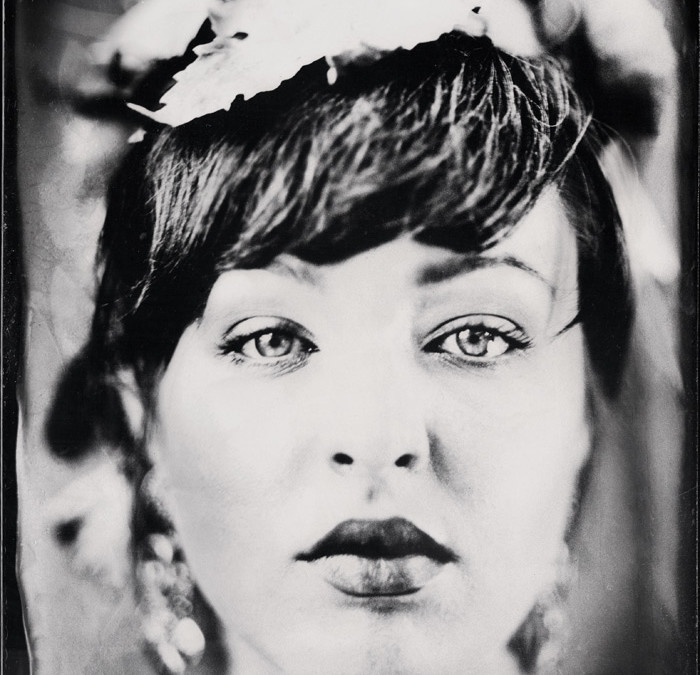 Carbon transfer is one of the most important (and beautiful) historical processes; along with gumprint and oilprint it is one of the essential techniques utilizing the light sensitivity of organic coloids sensitized with chromium salts. In the past, materials for carbon transfer used to be manufactured by the Autotype company (hence the other name of the process), today, they need to be manufactured by the photographer. As a curiosity, best attesting to the prestige the process used to be accompanied by, it should be remembered that many photographers of the past would offer their customers a choice of technique that would be used to make the prints they ordered. If the customer was less demanding (and less willing to spend money), one of the cheaper and simpler processes, such as the albumen print, would be used. Carbon transfer, along with the platinum print, would have been reserved for the most demanding customers who were willing to pay considerably more. Even though, similarly to the gumprint, carbon transfer utilises the fact that organic coloids, in this case gelatin, sensitized with potassium or ammonium bichromate change their properties and lose solubility in water, this is where similarities end. Carbon transfer prints, even those made from a single layer, are characterised by deep blacks, powerful expression and reach detail combined with subtle tonal variations. Carbon transfer combines power and subtlety and is equally suited to dramatic landscapes, medieval ruins an delicate female nudes. Today, after years of near oblivion, the process once more comes to favour offering advantages unattainable to most photographic processes, such as: excellent, almost unrivalled permanence of hundreds of years...
Carbon transfer is one of the most important (and beautiful) historical processes; along with gumprint and oilprint it is one of the essential techniques utilizing the light sensitivity of organic coloids sensitized with chromium salts. In the past, materials for carbon transfer used to be manufactured by the Autotype company (hence the other name of the process), today, they need to be manufactured by the photographer. As a curiosity, best attesting to the prestige the process used to be accompanied by, it should be remembered that many photographers of the past would offer their customers a choice of technique that would be used to make the prints they ordered. If the customer was less demanding (and less willing to spend money), one of the cheaper and simpler processes, such as the albumen print, would be used. Carbon transfer, along with the platinum print, would have been reserved for the most demanding customers who were willing to pay considerably more. Even though, similarly to the gumprint, carbon transfer utilises the fact that organic coloids, in this case gelatin, sensitized with potassium or ammonium bichromate change their properties and lose solubility in water, this is where similarities end. Carbon transfer prints, even those made from a single layer, are characterised by deep blacks, powerful expression and reach detail combined with subtle tonal variations. Carbon transfer combines power and subtlety and is equally suited to dramatic landscapes, medieval ruins an delicate female nudes. Today, after years of near oblivion, the process once more comes to favour offering advantages unattainable to most photographic processes, such as: excellent, almost unrivalled permanence of hundreds of years...
 If you have had enough of typical courses with participants diligently copying negatives previously prepared by the tutor and all leaving the workshop with identical pictures that are not really theirs; if you don’t want to go for a course lasting from 10a.m. till 6 p.m. where the cleaning lady pointedly enters the room half an hour before the end, we have a perfect offer for you. Join the workl of alternative photography learning the intricacies of one of the most important of them all, of the oilprint. Take part in a workshop during which you will not only work using the instructor’s negatives but will, above all, be able to prepare your own negatives that you will subsequently copy as oilprints with the help of an experienced instructor using the oilprint at the same time learning the secrets of the process and making your own art. Above all, the fact that the workshop lasts three days, it will not only offer an opportunity to learn the basics, but also to get practice in printing. Constant supervision and assistance from the tutor will make it possible to notice and eliminate errors as they appear. Oilprint is one of the most important alternative processes, popular especially with the great pictorial photographers. It allows unrivalled manual control over the final appearance of the print combined with a wonderful rendition of details. Experience acquired with oil printing will also prove priceless when you try the sister process of bromoil. We will begin the workshop by learning how to prepare our own materials, especially the papers which will later be used to create the prints....
If you have had enough of typical courses with participants diligently copying negatives previously prepared by the tutor and all leaving the workshop with identical pictures that are not really theirs; if you don’t want to go for a course lasting from 10a.m. till 6 p.m. where the cleaning lady pointedly enters the room half an hour before the end, we have a perfect offer for you. Join the workl of alternative photography learning the intricacies of one of the most important of them all, of the oilprint. Take part in a workshop during which you will not only work using the instructor’s negatives but will, above all, be able to prepare your own negatives that you will subsequently copy as oilprints with the help of an experienced instructor using the oilprint at the same time learning the secrets of the process and making your own art. Above all, the fact that the workshop lasts three days, it will not only offer an opportunity to learn the basics, but also to get practice in printing. Constant supervision and assistance from the tutor will make it possible to notice and eliminate errors as they appear. Oilprint is one of the most important alternative processes, popular especially with the great pictorial photographers. It allows unrivalled manual control over the final appearance of the print combined with a wonderful rendition of details. Experience acquired with oil printing will also prove priceless when you try the sister process of bromoil. We will begin the workshop by learning how to prepare our own materials, especially the papers which will later be used to create the prints....
 Discover the magic of the ambrotype together with the author of The Ambrotype – A Practical Guide – the first Polish textbook devoted to this fascinating process. Join our workshop and learn to make your photographs on glass using the methods of the masters of 1860’s and 1870’s, the methods used till this day by numerous photographers all over the world – to name just Sally Mann or Ian Ruhter. Learn all the necessary secrets of the process along with recipes and procedures enabling you to create unique works of art while discovering the charm of old photography. The magic of wetplate photography or, to be more specific, of ambrotypes, hasn’t passed for over 150 years which have passed since the invention of the technique. The image made of silver on glass, magical, glittering with subtle hues fascinates in the 21st century just as much as it did in the 19th. And just as it was in the times when it was invented, for most of us the technique still is a mystery, something almost mystical. It seems that it is even more of a mystery now than in the past. Our two-day workshop in making wetplate ambrotypes will not only allow participants to learn/revise the rules governing wetplate photography but will also offer practical opportunities to use these skills under the tutor’s guidance and with the help of professional models taking part in the workshop. The programme of the workshop covers: a quick revision of using large format cameras, a presentation of the wetplate ambrotype process including chemical recipes, preparing glass for ambrotype photography, coating glass with collodion, sensitizing,...
Discover the magic of the ambrotype together with the author of The Ambrotype – A Practical Guide – the first Polish textbook devoted to this fascinating process. Join our workshop and learn to make your photographs on glass using the methods of the masters of 1860’s and 1870’s, the methods used till this day by numerous photographers all over the world – to name just Sally Mann or Ian Ruhter. Learn all the necessary secrets of the process along with recipes and procedures enabling you to create unique works of art while discovering the charm of old photography. The magic of wetplate photography or, to be more specific, of ambrotypes, hasn’t passed for over 150 years which have passed since the invention of the technique. The image made of silver on glass, magical, glittering with subtle hues fascinates in the 21st century just as much as it did in the 19th. And just as it was in the times when it was invented, for most of us the technique still is a mystery, something almost mystical. It seems that it is even more of a mystery now than in the past. Our two-day workshop in making wetplate ambrotypes will not only allow participants to learn/revise the rules governing wetplate photography but will also offer practical opportunities to use these skills under the tutor’s guidance and with the help of professional models taking part in the workshop. The programme of the workshop covers: a quick revision of using large format cameras, a presentation of the wetplate ambrotype process including chemical recipes, preparing glass for ambrotype photography, coating glass with collodion, sensitizing,...





Recent Comments